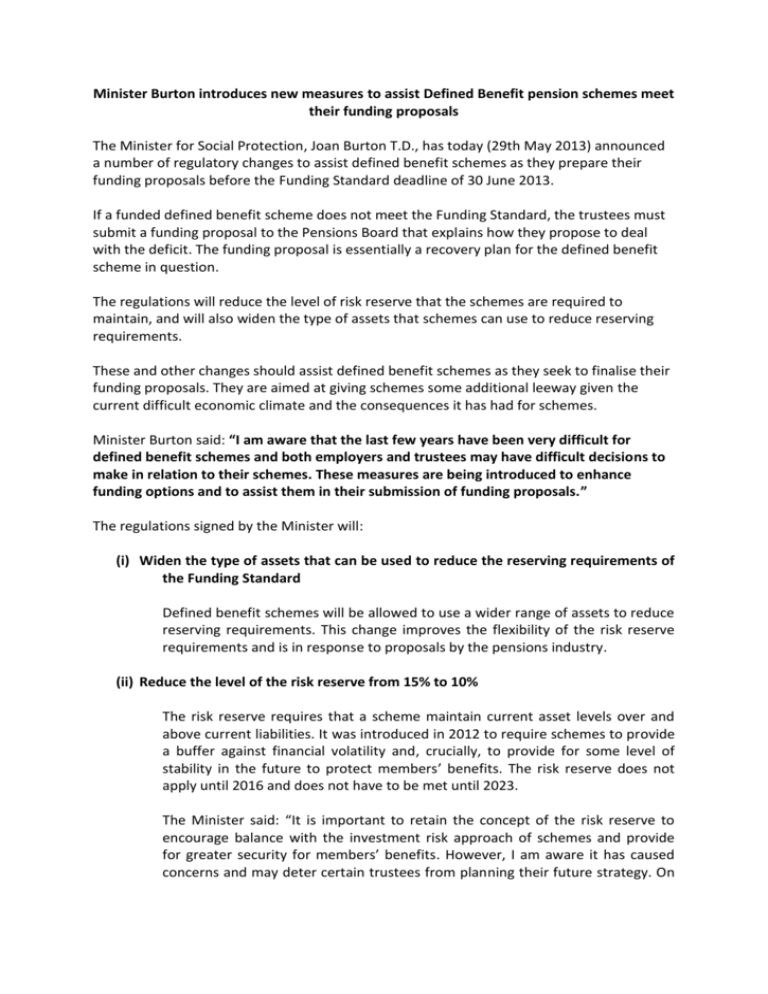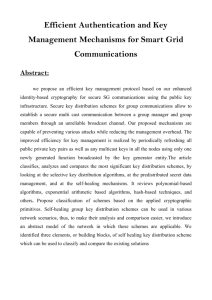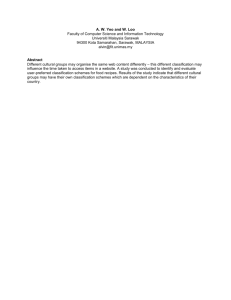Minister Burton introduces new measures to assist Defined Benefit
advertisement

Minister Burton introduces new measures to assist Defined Benefit pension schemes meet their funding proposals The Minister for Social Protection, Joan Burton T.D., has today (29th May 2013) announced a number of regulatory changes to assist defined benefit schemes as they prepare their funding proposals before the Funding Standard deadline of 30 June 2013. If a funded defined benefit scheme does not meet the Funding Standard, the trustees must submit a funding proposal to the Pensions Board that explains how they propose to deal with the deficit. The funding proposal is essentially a recovery plan for the defined benefit scheme in question. The regulations will reduce the level of risk reserve that the schemes are required to maintain, and will also widen the type of assets that schemes can use to reduce reserving requirements. These and other changes should assist defined benefit schemes as they seek to finalise their funding proposals. They are aimed at giving schemes some additional leeway given the current difficult economic climate and the consequences it has had for schemes. Minister Burton said: “I am aware that the last few years have been very difficult for defined benefit schemes and both employers and trustees may have difficult decisions to make in relation to their schemes. These measures are being introduced to enhance funding options and to assist them in their submission of funding proposals.” The regulations signed by the Minister will: (i) Widen the type of assets that can be used to reduce the reserving requirements of the Funding Standard Defined benefit schemes will be allowed to use a wider range of assets to reduce reserving requirements. This change improves the flexibility of the risk reserve requirements and is in response to proposals by the pensions industry. (ii) Reduce the level of the risk reserve from 15% to 10% The risk reserve requires that a scheme maintain current asset levels over and above current liabilities. It was introduced in 2012 to require schemes to provide a buffer against financial volatility and, crucially, to provide for some level of stability in the future to protect members’ benefits. The risk reserve does not apply until 2016 and does not have to be met until 2023. The Minister said: “It is important to retain the concept of the risk reserve to encourage balance with the investment risk approach of schemes and provide for greater security for members’ benefits. However, I am aware it has caused concerns and may deter certain trustees from planning their future strategy. On that basis, I want to introduce some flexibility and am reducing the level of the reserve from 15% to 10%.” (iii) Changes to reflect bond yields The Section 42 guidance in relation to the Pensions Act is changing to reflect recent changes in bond yields. The impact of the proposed change is to ensure that schemes can value pensions in payment on a sovereign annuities basis to the extent that the scheme holds matching sovereign bonds. The change will make it easier for schemes which hold sovereign bonds to obtain credit under the Funding Standard in situations where the yield is reduced. Minister Burton said: “In addition, I am delaying for now the introduction of proposed changes to the calculation of transfer values which would have had the effect of increasing schemes’ liabilities. Employers, unions and trustees have been making strenuous efforts to protect the viability of their schemes and I want to support them in every way possible. “While the recent OECD Review of the Irish Pension System describes the Funding Standard as ‘undemanding’, I am aware that many schemes are coming from a deficit position and that this is a difficult problem that requires careful management. “I expect all defined benefit schemes to submit their proposals to the Pensions Board. Compliance with the regulatory structure is essential for the future sustainability of defined benefit schemes and increased security of members’ benefits. It will also ensure that we ascertain the precise funding position of defined benefit schemes and assess the way in which schemes have availed of the supportive measures introduced by the Government, particularly sovereign annuities/bonds.” ENDS Notes to Editors: Section 44(2)(a)(iv) of the Pensions Act gives the Minister power to prescribe additional assets as having the effect of reducing the reserve required under the Funding Standard on the grounds that they offer a similar degree of security to the assets already identified. These regulations prescribe the following additional asset classes which have the effect of reducing the funding standard reserve requirement: 1. Bonds, which although not issued by an EU Member State are guaranteed by an EU Member State; 2. Bonds issued by various bodies which are considered to be financially very secure (These are listed in article 3(b) of the regulations); 3. Euro-denominated bonds issued by any entity (e.g. a company) where the investment yield does not exceed the yield on an identified German bond by more than a specified percentage; 4. Assets invested by a scheme in a collective investment fund or an insurance policy to the extent that the underlying assets are assets which have been specified in Section 44(2)(a) of the Pensions Act and in these regulations and which have the effect of reducing the Funding Standard reserve requirement; 5. Annuities and sovereign annuities held by a pension scheme.





